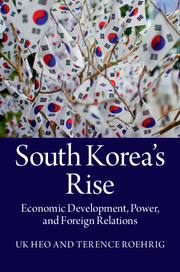Book contents
- Frontmatter
- Dedication
- Contents
- List of figures
- List of tables
- Acknowledgements
- 1 Introduction
- 2 Economic development, state power, and foreign policy
- 3 Inter-Korean relations: confrontation, economic exchanges, and the nuclear crisis
- 4 South Korea and the United States: from dependency to partnership
- 5 South Korea, Russia, and China: from adversaries to economic partners
- 6 South Korea and Japan: an ambivalent relationship
- 7 South Korea and the European Union: evolving cooperation and competition
- 8 South Korea and India: opportunities and obstacles
- 9 South Korea and the developing world: Africa, Latin America, the Middle East, and Southeast Asia
- 10 Contributing to the international community: from consumer to producer
- 11 Conclusion
- Bibliography
- Index
11 - Conclusion
Published online by Cambridge University Press: 05 July 2014
- Frontmatter
- Dedication
- Contents
- List of figures
- List of tables
- Acknowledgements
- 1 Introduction
- 2 Economic development, state power, and foreign policy
- 3 Inter-Korean relations: confrontation, economic exchanges, and the nuclear crisis
- 4 South Korea and the United States: from dependency to partnership
- 5 South Korea, Russia, and China: from adversaries to economic partners
- 6 South Korea and Japan: an ambivalent relationship
- 7 South Korea and the European Union: evolving cooperation and competition
- 8 South Korea and India: opportunities and obstacles
- 9 South Korea and the developing world: Africa, Latin America, the Middle East, and Southeast Asia
- 10 Contributing to the international community: from consumer to producer
- 11 Conclusion
- Bibliography
- Index
Summary
In the 1950s South Korea was one of the poorest countries in the world, with a per capita GNP of approximately $60 and about half of its government budget coming from US aid. Five decades later, South Korea is an economic powerhouse with the twelfth largest economy in the world at $1.156 trillion. In 1996 South Korea joined the Organisation for Economic Co-operation and Development (OECD), and it became a member of the prestigious OECD Development Assistance Committee (DAC) in 2009. South Korea is the only country in the world that has transformed itself from an aid recipient to an international donor.
The success story of South Korea has attracted significant scholarly attention in political science and economics alike. The majority of studies have focused on how South Korea achieved such fast economic development and what factors drove its phenomenal growth. Another body of literature has explored the relationship between economic development and democratization in South Korea. Yet, despite the plethora of studies, few have investigated how South Korea’s economic development has affected its foreign policy and international relations. Thus, in this book we have developed a theory to explain the relationship between economic development and foreign policy and applied that to the South Korean case.
- Type
- Chapter
- Information
- South Korea's RiseEconomic Development, Power, and Foreign Relations, pp. 183 - 189Publisher: Cambridge University PressPrint publication year: 2014

